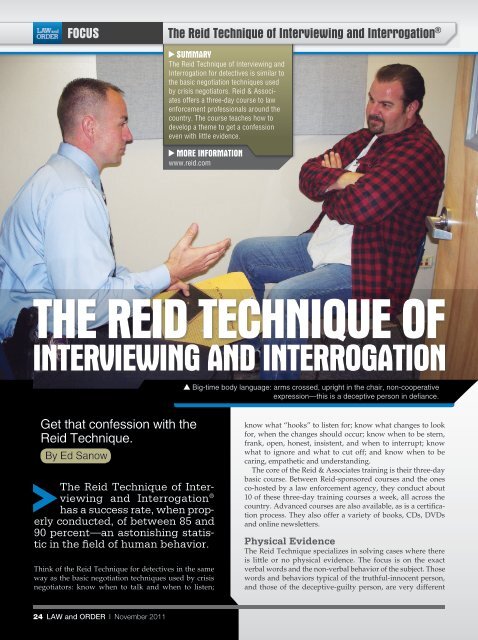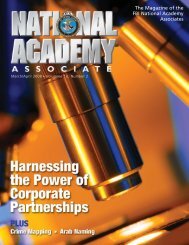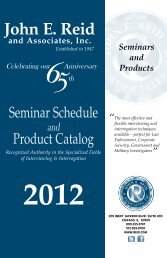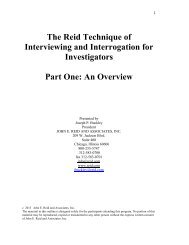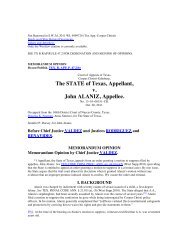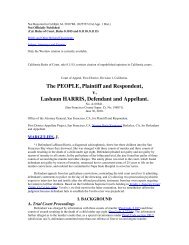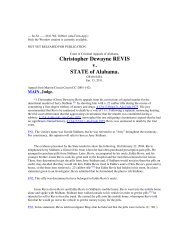THE REID TECHNIQUE OF
INTERVIEWING AND INTERROGATION - The Reid Technique of ...
INTERVIEWING AND INTERROGATION - The Reid Technique of ...
- No tags were found...
Create successful ePaper yourself
Turn your PDF publications into a flip-book with our unique Google optimized e-Paper software.
FOCUS The Reid Technique of Interviewing and Interrogation ®<br />
SUMMARY<br />
The Reid Technique of Interviewing and<br />
Interrogation for detectives is similar to<br />
the basic negotiation techniques used<br />
by crisis negotiators. Reid & Associates<br />
offers a three-day course to law<br />
enforcement professionals around the<br />
country. The course teaches how to<br />
develop a theme to get a confession<br />
even with little evidence.<br />
MORE INFORMATION<br />
www.reid.com<br />
<strong>THE</strong> <strong>REID</strong> <strong>TECHNIQUE</strong> <strong>OF</strong><br />
INTERVIEWING AND INTERROGATION<br />
Big-time body language: arms crossed, upright in the chair, non-cooperative<br />
expression—this is a deceptive person in defiance.<br />
Get that confession with the<br />
Reid Technique.<br />
By Ed Sanow<br />
The Reid Technique of Interviewing<br />
and Interrogation ®<br />
has a success rate, when properly<br />
conducted, of between 85 and<br />
90 percent—an astonishing statistic<br />
in the field of human behavior.<br />
Think of the Reid Technique for detectives in the same<br />
way as the basic negotiation techniques used by crisis<br />
negotiators: know when to talk and when to listen;<br />
know what “hooks” to listen for; know what changes to look<br />
for, when the changes should occur; know when to be stern,<br />
frank, open, honest, insistent, and when to interrupt; know<br />
what to ignore and what to cut off; and know when to be<br />
caring, empathetic and understanding.<br />
The core of the Reid & Associates training is their three-day<br />
basic course. Between Reid-sponsored courses and the ones<br />
co-hosted by a law enforcement agency, they conduct about<br />
10 of these three-day training courses a week, all across the<br />
country. Advanced courses are also available, as is a certification<br />
process. They also offer a variety of books, CDs, DVDs<br />
and online newsletters.<br />
Physical Evidence<br />
The Reid Technique specializes in solving cases where there<br />
is little or no physical evidence. The focus is on the exact<br />
verbal words and the non-verbal behavior of the subject. Those<br />
words and behaviors typical of the truthful-innocent person,<br />
and those of the deceptive-guilty person, are very different<br />
24 LAW and ORDER I November 2011<br />
Law_Nov_Focus.indd 24<br />
12/14/2011 1:37:20 PM
INVESTIGATIONS<br />
and surprisingly easy to recognize.<br />
Non-verbal behavior is more reliable than spoken words.<br />
Non-verbal behavior is responsible for more than half of the<br />
meaning of the communicated message. Non-verbal behavior<br />
may support, or contradict, the verbal words. The key is how<br />
to evaluate what the detective sees and hears. But most importantly,<br />
the Reid Technique teaches how to develop a theme or<br />
series of themes to spring the trap even with very little supporting<br />
evidence.<br />
In Reid-speak, a theme is a face-saving, rationalized, or good<br />
and acceptable excuse (in the mind of the guilty) for why they<br />
committed the crime. This is a critical part of the Reid Technique.<br />
After a carefully structured preparation, the suspect is<br />
going to be given the choice between a really good reason and<br />
a much worse, less-acceptable reason for having committed the<br />
crime. Accepting either is an admission of guilt. And properly<br />
timed, it works.<br />
Investigative Interview<br />
The Reid Technique picks up where the routine criminal investigation<br />
leaves off. This course does not deal with the basics<br />
investigation. It assumes all of the facts and physical evidence<br />
have been gathered. Instead, the Reid Technique is about interviewing<br />
and then interrogating, which are two separate and<br />
very different phases.<br />
Even the interviewing phase of the Reid Technique picks<br />
up after all the standard clerical, non-threatening, background<br />
questions are asked. This phase begins with all the who, what,<br />
when, where, why and how questions, all of which may have<br />
been asked of the suspect before by another officer.<br />
During this phase, the Reid Technique teaches the detective<br />
to pay attention to comments volunteered, or answers to questions,<br />
that can be later used to develop the theme—that good,<br />
face-saving excuse for why the suspect did the deed. Theft<br />
of money? Listen for problems paying bills—even if you are<br />
pretty sure this is not the reason for the theft. Sexual assault?<br />
Listen for comments about provocative actions or clothes.<br />
This phase moves to one of the Reid Technique trademarks…<br />
behavior-provoking questions. These are a series of 17 primary<br />
questions where the responses (both verbal and non-verbal) of<br />
a truthful person are clearly different from those of a deceitful<br />
person. Of the 17 innocent sounding, thought-provoking<br />
questions, only half of them will need to be asked for the detective<br />
to have confidence about innocence or guilt.<br />
These are the kind of questions designed to elicit some kind<br />
of a response. The detective must carefully watch the suspect<br />
before, during and just after the answer to note that response.<br />
The detective is looking for attitude, body posture, eye contact,<br />
tension-relieving gestures, facial expressions, as well as listening<br />
for the precise verbal content.<br />
With attitude, both truthful and deceptive persons can be<br />
nervous, fearful and angry. The timing of their anger, and if it<br />
is constant, spikes or diminishes, are all factors indicating guilt<br />
or innocence. Facial expressions, of course, reflect the person’s<br />
attitude. Look for sincere expressions as opposed to the phony,<br />
fake, rehearsed ones.<br />
Forward or upright in the chair, head up, eyes looking<br />
at investigator, open arms—he is listening, and the<br />
investigator needs to keep him listening.<br />
With the head down, shoulders slumped, looking at the<br />
floor, yielding, the deceptive person now totally defeated.<br />
www.lawandordermag.com 25<br />
Law_Nov_Focus.indd 25<br />
12/14/2011 1:37:26 PM
FOCUS<br />
The Reid Technique of Interviewing and Interrogation ®<br />
Body Posture<br />
Body posture is pretty easy to read,<br />
but watch for changes in posture in response<br />
to specific questions. Tension,<br />
anxiety and stress-relieving gestures are<br />
important and also pretty easy to read.<br />
The key is to correlate the timing and<br />
the consistency of these gestures with<br />
the exact behavior-provoking questions.<br />
Eye contact is important—the eyes are<br />
windows to the soul—but should be put<br />
in perspective with all the other nonverbal<br />
indicators. Normal eye contact is<br />
maintained between 30 and 60 percent<br />
of the time in normal conversations<br />
between two people. Be careful not to<br />
rely too much on this one aspect.<br />
In the same way, a neurolinguistic<br />
evaluation may be over-rated. (This<br />
is where the subject breaks the gaze<br />
up and left, or down and to the right.)<br />
Instead, during the clerical, non-threatening<br />
part of the interview, concentrate<br />
on establishing the normal baseline of<br />
eye contact this person uses.<br />
The interrogation theme is a good excuse, a face-saving way for the suspect to<br />
admit guilt…but it has to be one the suspect buys into as his own.<br />
Choose a bumper today<br />
Our new Universal, SUV Standard Push Bumper<br />
!"#$%"!&'%$#()#*%%(#+),-#.%%(#%/,!0*%'(#'%%$"#!'#<br />
today’s economy. *Transferable between any Police<br />
12342&%#567"8#(9!"#:,*0%-#32'#9%;0#)'#%/,!0*%'(#<br />
costs down the road.<br />
INVESTIGATIONS<br />
Verbal Responses<br />
As for the spoken answers to behavior-provoking<br />
questions, most people<br />
will tell a direct lie only as a last resort.<br />
Instead, the deceptive person will give<br />
an evasive answer, a vague answer,<br />
a delayed answer, or a non-answer<br />
like a head shake or shoulder shrug.<br />
The guilty, deceptive person will try to<br />
manipulate the detective.<br />
The verbal response may also change<br />
in rate of speech, pitch/tone, and<br />
volume depending on what is being<br />
answered or described. In fact, in some<br />
cases, when the manner of speech does<br />
not change, that should attract the attention<br />
of the detective.<br />
Two of the more revealing Reid Technique<br />
questions are: “What do you think<br />
should happen to a person who did this<br />
crime?” and “Do you think the person<br />
who did this would deserve a second<br />
chance under any circumstance?” Truthful-innocent<br />
people and guilty-deceptive<br />
people give very different answers<br />
to these questions. The Reid Technique<br />
has 15 more primary behavior-provoking<br />
questions such as these, as well as<br />
a dozen secondary behavior-provoking<br />
questions.<br />
Transition Phase<br />
During the investigative interview<br />
phase of the Reid Technique, the<br />
detective is completely non-judgmental,<br />
non-threatening, non-accusatory and<br />
non-confrontational. At no time, should<br />
the detective signal by his own verbal or<br />
non-verbal behavior any kind of suspicion<br />
of guilt or conclusion of innocence.<br />
After a short break “to check on further,<br />
expected information related to this<br />
case,” the detective makes a transition.<br />
The transition is from the interview to<br />
the positive-confrontation interrogation.<br />
With firm and direct language, the<br />
detective tells the suspect the results<br />
of the investigation clearly show the<br />
person is guilty of the crime.<br />
This will be the first time the suspect<br />
gets this message from the formerly<br />
non-confrontational detective, and that<br />
change in the detective’s approach will<br />
be part of the wake-up call. Note the<br />
verbal and non-verbal response.<br />
Then the detective will immediately<br />
transition roles again—this time from<br />
being an accuser to being sympathetic<br />
and understanding. The detective is trying<br />
to figure out why this “otherwise<br />
good person make this one-time mistake<br />
in judgment.” What factors, people or<br />
circumstances simply forced the suspect<br />
to do this?<br />
Interrogation Theme<br />
The most important phase of the Reid<br />
Technique is developing and delivering<br />
the interrogation theme. The theme,<br />
again, is a good reason, excuse or facesaving<br />
way for the guilty person to<br />
admit guilt. The detective develops the<br />
!"#$%$&'(#%&)"&(#<br />
*+&*",-."&(/#<br />
!"#012(#3"45"*("$#%(6<br />
!" #$%&'()"*+),-+,&("<br />
" ./'0"%'12$,<br />
!" 3'04-,5-11$))",'")&*6$<br />
!" 7&&'8)"-11$))",'"<br />
" 0-9-:*+$"/$&$-)$<br />
!" ;*+9$/"
FOCUS<br />
The Reid Technique of Interviewing and Interrogation ®<br />
theme by carefully listening to the suspect<br />
during the interview phase. That<br />
is, the theme must be an excuse or reason<br />
the suspect will buy into and adopt<br />
as his own. It has to be something he<br />
thinks anyhow.<br />
The entire concept of the theme is to<br />
place the blame on someone or something<br />
else, other than the suspect. The<br />
suspect is not likely to outright admit<br />
guilt. However, the theme allows him to<br />
tie his admission of guilt with a really<br />
good, reasonable excuse to save selfrespect.<br />
As a part of this, the detective<br />
can downplay what the suspect did—<br />
contrast it to something much worse<br />
that he did not do.<br />
The theme, the excuse, can be almost<br />
anything. However, it needs to relate to<br />
the crime, and it has to be something the<br />
suspect can adopt as his own. It must hit<br />
close to home or the suspect will reject or<br />
ignore it. That is why the detective must<br />
listen so carefully during the interview<br />
for what would make good themes for<br />
this particular suspect.<br />
The Reid Technique workbook has<br />
dozens and dozens of such themes,<br />
divided by the crime. A list of good<br />
excuses for shoplifting is obviously<br />
different from a list of good excuses<br />
for child molesting. If the theme (excuse)<br />
is good enough, anyone would know<br />
the person had no choice but to do the<br />
crime. That is the kind of theme the<br />
detective wants to find.<br />
Blame Someone Else<br />
While really good excuses for committing<br />
the crime are almost endless, they<br />
all involve putting the blame somewhere<br />
else. It was the way she dressed.<br />
He was flaunting his money. It was the<br />
alcohol. If someone else had just been<br />
doing their job. It was someone else’s<br />
idea. It was just circumstances—an opportunity<br />
came up and you gave into<br />
temptation like anyone would do.<br />
Because this is the cornerstone of the<br />
Reid Technique, a great deal of time is<br />
spent on learning how to listen for clues<br />
for what would be a couple of credible<br />
themes with this particular suspect.<br />
During the interrogation, if one theme<br />
doesn’t resonate with the suspect, the<br />
detective needs to keep presenting other<br />
themes until he gets interest from the<br />
suspect. The detective will begin the interrogation<br />
with the most likely theme.<br />
Denials & Objections<br />
The themes are delivered in a non-stop<br />
monologue. Of course, the suspect may<br />
try to interrupt—any interruption will<br />
be a denial. Do not let the suspect interrupt.<br />
Cut off their denials and return<br />
to the theme. Tell them they had their<br />
chance to explain during the interview.<br />
Heavy denials, or the opposite extreme,<br />
total withdrawal, are probably signs the<br />
theme the detective has selected is just<br />
not registering. Drop that one and go on<br />
to the next one.<br />
Guilty people use a standard set of deceptive<br />
denials. In a few instances, the<br />
detective will make an error in judgment<br />
and move truly innocent people from<br />
the interview phase to the interrogation<br />
phase. Innocent people will use a different<br />
set of truthful denials. The detective<br />
has to recognize the differences, which<br />
are sometimes subtle. The guilty person<br />
will eventually learn the denials are not<br />
working and move on to objections.<br />
Objections are different from denials.<br />
Cut off denials but listen to objections.<br />
What they say in the objection will<br />
help the detective to refine the theme,<br />
or develop a new theme. In fact, objections<br />
may more clearly point to a theme<br />
that will work better than the one the<br />
detective developed based on the nonconfrontational<br />
interview. Don’t try to<br />
refute the objection. Instead, draw it out<br />
and use it against him.<br />
The guilty person will eventually figure<br />
out the detective is not listening to<br />
the denials and is turning the objections<br />
against him. They might just withdraw<br />
and mentally tune-out the detective.<br />
At this point, they will start to focus on<br />
the consequences of telling the truth.<br />
The detective must get the suspect to<br />
focus back on the theme.<br />
The Reid Technique has several ways<br />
to do this. Some are as simple as leaning<br />
in closer to the suspect and attempting<br />
to establish eye contact.<br />
Click on EInfo at - www.lawandordermag.com reader service #19<br />
28 LAW and ORDER I November 2011<br />
Law_Nov_Focus.indd 28<br />
12/14/2011 1:37:30 PM
INVESTIGATIONS<br />
The Alternative Question<br />
When the suspect decides to tell the<br />
truth—linked with a really good<br />
excuse—he will go into a passive,<br />
defeated mode. This will be obvious by<br />
a number of non-verbal behaviors.<br />
However, they may still need incentive<br />
to tell the truth. That incentive is the<br />
alternative question.<br />
The alternative question is the second<br />
most important step in the Reid Technique.<br />
Timing of this question is critical.<br />
Accepting either one of the two choices<br />
in these questions is an admission of<br />
guilt. If asked too soon, the suspect will<br />
realize this and consider it a trick. Later<br />
in the process, the same exact question<br />
will elicit an admission of guilt.<br />
The alternative question is simply<br />
a choice between a good excuse<br />
for the crime and a bad excuse for the<br />
crime. Either choice is incriminating.<br />
Once the suspect goes into a receptive,<br />
defeated mode, the detective will offer the<br />
suspect an alternative question based on<br />
the theme that has worked.<br />
With a verbal admission, the hard part is over; however, the Reid Technique<br />
moves on to getting incriminating details and obtaining the written statement.<br />
At the same time, the detective will<br />
contrast what the suspect did with<br />
something much worse. This serves to<br />
downplay the seriousness of the crimes<br />
and feared consequences. “They could<br />
afford to be robbed, but at least you<br />
didn’t hurt them during the robbery.”<br />
The good excuse, the good theme, the<br />
good choice is based on human weaknesses<br />
and temptations that everyone<br />
has. The good choice involves someone<br />
else’s fault, someone else’s provocation,<br />
or something that would force literally<br />
anyone into doing the crime. The bad<br />
choice is based on what is generally considered<br />
repulsive, degenerate, perverted<br />
or totally unacceptable behavior.<br />
The alternative question can take<br />
many forms, but five main ones are<br />
frequently used. First, are you sorry<br />
for what you did, or do you simply not<br />
care? Second, was this the first time,<br />
or was it just one of many? Third, was<br />
this a spur of the moment thing, a loss<br />
of control, or was this something you<br />
carefully planned out? Fourth, have<br />
you learned from all this and are never<br />
going to do it again, or something you<br />
think you will keep doing? Fifth, were<br />
you talked into this, was it peer pressure,<br />
were you threatened, or was this<br />
all your own idea?<br />
Keep asking the alternative question,<br />
or series of alternative questions. Then<br />
ask them in a leading manner. “This<br />
was the only time, wasn’t it?” “You are<br />
sorry, aren’t you?” When the detective<br />
gets the admission, reinforce it. “Good,<br />
that is what I thought. I knew you were<br />
basically a good person.”<br />
Details of the Offense<br />
An initial verbal admission in response<br />
to answering leading questions is a long<br />
way from a full confession with details of<br />
the crime. However, the hard part is over.<br />
With the same empathy the detective<br />
has shown almost the entire time, elicit<br />
a narrative of the crime, tie the suspect<br />
to the crime with incriminating details,<br />
and move on to the written statement.<br />
The Reid Technique includes a number<br />
of methods to smooth the transition and<br />
limit the chances for a retraction.<br />
During the three-day course, each<br />
aspect of the behavior symptom analysis<br />
and each of the nine steps of interrogation<br />
are reinforced by video of actual interviews.<br />
Expect to see 15 to 20 interview<br />
or interrogation segments on crimes<br />
ranging from murder by stabbing, theft<br />
of evidence, child molesting, shots<br />
fired into passing vehicle, false claim of<br />
abduction, forged checks, drug dealing<br />
and armed robbery at an ATM.<br />
The overall assessment? Every detective<br />
should attend the course. And not<br />
just new detectives. It will help every detective<br />
who has had the guilty suspect<br />
sitting right in front of them, but just<br />
couldn’t get the confession. The threeday<br />
course is also excellent for all patrol<br />
officers and sheriff’s deputies in smaller<br />
towns and cities without detective units<br />
– where the same patrol officer takes the<br />
initial call, performs the investigation,<br />
and conducts the interview. The Reid<br />
Technique deserves its legendary status<br />
in law enforcement.<br />
Photos courtesy of Steve Tracy.<br />
LaO<br />
Post your comments on this story by visiting<br />
www.lawandordermag.com<br />
www.lawandordermag.com 29<br />
Law_Nov_Focus.indd 29<br />
12/14/2011 1:37:33 PM


